Women in space



Women in space have been present and active since the beginning of human spaceflight. Since then a considerable number of women from a range of countries have worked in space, though overall women are still significantly less often chosen to go to space than men and represent by 2020 only 10% of all astronauts who have been to space.[2]
The first women ever to enter space was Valentina Tereshkova, a former textile-factory assembly worker from the Yaroslavl Region in the Soviet Union.[3] By October 2021 most of the 70 women who have been to space, have been United States citizens, with missions on the Space Shuttle and on the International Space Station. Other countries have had one (United Kingdom, France, South Korea, Italy) or two (USSR, Canada, Japan, Russia, China) women citizens in space, taking part in missions of programs with human spaceflight capability. Additionally one dual Iranian-US woman citizen has participated as tourist on a US mission.
Women face many of the same physical and psychological difficulties of spaceflight as men. Scientific studies generally show no particular adverse effect from short space missions. It has even been concluded that women might be better suited for longer space missions.[4] The main obstacle for women to go to space remains gender discrimination.[5][6]
Women in human spaceflight programs[]
Overall history[]
Human spaceflight began in the late 1950s and early 1960s and early research on possible crewed missions to space studied the expected effects of space on humans, also considering women. The research showed that women might even be suited better for space missions due to a range of reasons.[7]
In the competition between the Soviet Union (USSR) and the United States known as the Space Race both nations chose their first space pilots (known as cosmonauts in the USSR and astronauts in the US) for their programs from the ranks of their military high-speed jet test pilots, who were exclusively men.
The first woman to fly to space became Valentina Tereshkova aboard Vostok 6 on June 16th 1963, completing a 70.8 hour flight making a total of 48 orbits before returning to Earth. The USSR did not send another woman until 1982, when Svetlana Savitskaya became the second woman to enter space. It was not until 1983 that the first American woman, Sally Ride, would enter space.
Following Ride's NASA Astronaut Group 8 mission, a range of women have completed space flight. Despite this, women still represent only about 10% of all people who have gone to space, being less chosen and enabled.[2]
All the missions to the moon have included only male astronauts, and there has yet to be a female astronaut return from the Moon, a goal that the US Artemis program is pursuing.
Soviet Union (USSR)[]

The USSR director of cosmonaut training Nikolai Kamanin started in 1961 to lobby for having women as cosmonauts after being inspired by repeated questions by the press about women as cosmonauts.[7] Subsequently Kamanin crucially gained space program leader Sergey Korolev as a supporter, getting approval six months later for women cosmonauts.[7] During a visit to the US in 1962 Kamanin got to know Jerrie Cobb of the then rejected "Mercury 13",[7] her being consultant to the NASA space program since 1961 and testifying in July 1962 at Congress about the positive results of "Mercury 13" and on gender discrimination. At one point Kamanin noted in his diary "We cannot allow that the first woman in space will be American. This would be an insult to the patriotic feelings of Soviet women."[8] To increase the odds of sending a Soviet woman into space first, the women cosmonauts began their training before the men.[8]
Valentina Tereshkova was the only one of the five to fly into space in Vostok 6 in June 1963, with Irina Solovyova as her first backup.[9] Kamanin framed her as "Gagarin in a skirt"[10] and Soviet Premier Nikita Khrushchev was happy with the propaganda potential of her selection, since she was the daughter of a collective farm worker who died in the Winter War, and confirmed her selection.[10] Five months after her flight, Tereshkova married Vostok 3 cosmonaut Andriyan Nikolayev on November 3, 1963 at the Moscow Wedding Palace, with Khrushchev presiding at the wedding party together with top government and space program leaders.[11] Kamanin described the marriage as "probably useful for politics and science".[12] On 8 June 1964, nearly one year after her space flight, she gave birth to their daughter Elena Andrianovna Nikolaeva-Tereshkova, the first person with a mother and father who had both traveled into space.[13]
Kamanin hoped to fly two other women on the Voskhod 3 and 4 flights, but these were canceled in 1965, leaving the women with Soviet Air Force officer commissions.

In 1978 Tereshkova and Tatyana Kuznetsova pushed for a new cosmonaut program for women,[7] but only in 1980 did the USSR start a second training of women cosmonauts, sending the world's second woman, Svetlana Savitskaya, in 1982 to space on the Soyuz T-7. Subsequently she also became the first woman to fly to space twice, on the Soyuz T-12 mission on July 25, 1984, and the first woman to walk in space (extravehicular activity, EVA) outside the Salyut 7 space station on that mission.[14]
After the first twelve US women, the third and last woman launched by the USSR was Helen Sharman in 1991, the first woman from Western Europe and the first who went to the space station Mir. She is the first and only United Kingdom woman citizen to date, making the United Kingdom the first of two countries (the other being South Korea) to have a woman as its first person to go to space. Allthough, she was not sent by the United Kingdom government since she was privately funded by Project Juno, the second person and first woman to be funded privately to go to space.
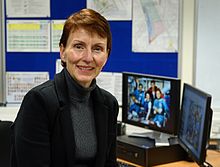
United States[]
In 1959 a group of thirteen female US pilots, dubbed by the American press as the "Mercury 13", wanted the chance to become astronauts and took, supervised by NASA staff, the same medical tests as the men, performing the same and even better.[7] Funded privately (e.g. by aviation pioneer Jacqueline Cochran) it was no government program and the idea of female astronauts faced a great deal of resistance in the US government, military command, and NASA, leaving these women no chance of becoming astronauts.[15] Though Jerrie Cobb of the "Mercury 13" became consultant to the NASA space program in 1961 and testifyied in July 1962 at Congress about the positive results of "Mercury 13" and on gender discrimination.[7]
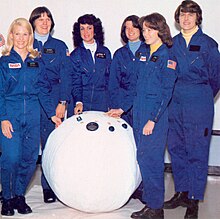
By 1976 it was decided that the NASA Astronaut Group 8 would include women and persons of minorities. Actor Nichelle Nichols, who played Nyota Uhura in the Star Trek franchise, had been using her public standing to speak for women and people of color and against their exclusion from the human space program of the US. Subsequently NASA reacted by employing her to assist in finding candidates for Group 8 and its future Space Shuttle program. Nichols successfully recruited the first people of color and women into the US space program.[16][17] One of the recruits was mission specialist Sally Ride,[16] who in 1983 became the first US woman to fly in space, in the seventh Space Shuttle mission.[14], and the third woman to fly in space.[14] Since then more than 50 of the several hundred American astronauts who have entered space have been women. Most served on the various Space Shuttle flights from 1983 to 2011.
Judith Resnik was the second American woman in space and the fourth woman overall in space, as a mission specialist on the maiden voyage of Discovery, from August to September 1984,[18] dying less than a year and a half later when the Space Shuttle Challenger was destroyed.
The first US woman to perform Extravehicular activity (EVA) was Kathryn D. Sullivan on the STS-41-G, which launched on October 11, 1984.[14] Mae Jemison became the first woman of color in space in 1992. The first woman to pilot the Space Shuttle was Eileen Collins who piloted Discovery on STS-63 (in 1995) and Atlantis on STS-84, and became the first female Shuttle commander on STS-93. The first woman on an ISS expedition crew was Susan Helms on Expedition 2, which lasted from March 2001 until August 2001.[14]

In 2007 Peggy Whitson became the first woman to command the International Space Station.[19] The 2013 NASA Astronaut Group 21 was the first astronaut class with an equal amount of women,[20] with the subsequent and current Group 22 having a lower number again.[21] On October 18, 2019, the first all female spacewalk was conducted by Jessica Meir and Christina Koch.

Only 12 humans, all men, have ever walked on the Moon; all human Moon missions were part of the U.S. Apollo program between 1969 and 1972.[22] No woman has ever walked on the Moon.[22] In 2020, NASA's communication director reported that NASA planned to land astronauts on the Moon, including possibly a woman astronaut or astronauts, as part of the U.S. Artemis program.[22][23] Of the 18 candidates in the Artemis program, nine are women: Nicole Aunapu Mann, Kayla Barron, Christina Koch, Kate Rubins, Stephanie Wilson, Jessica Meir, Jasmin Moghbeli, Anne McClain and Jessica Watkins.[23] No astronaut has yet been assigned to any specific Artemis mission.[23]
In addition to US citizens, US rockets have launched international astronauts. Roberta Bondar (in 1992) and Julie Payette (in 1999 and 2009) from Canada, as well as Chiaki Mukai (in 1994 and 1998) and Naoko Yamazaki (in 2010) of Japan flew as part of the US space program.
Russian Federation[]
The human spaceflight program of the Russian Federation called Roscosmos is the successor to the Soviet program and has sofar hosted two women. Still chosen as cosmonaut during Soviet times Yelena V. Kondakova became in 1994 the first woman cosmonaut for the Russian Federation, and the first woman to travel for both the Soyuz program and on the Space Shuttle. Twenty years later Yelena Serova became the second of the Russian Federation, and first Russian woman cosmonaut to visit the International Space Station on September 26, 2014.[24]
Russia’s only current woman cosmonaut, Anna Kikina, was admitted to the Russian cosmonaut corps in 2012. In 2019 Roscosmos announced changes to their space suits to accommodate women[6] and announced in 2020 that Kikina was selected for a flight to the International Space Station in 2022. [25]
The Russian space program has also hosted international cosmonauts. Claudie Haigneré from France (1996 and 2001), Anousheh Ansari from Iran (2006), Yi So-yeon of South Korea (2008) and Samantha Cristoforetti from Italy (2014).
Canada[]
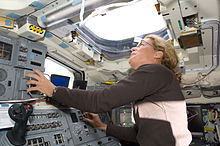
Roberta Bondar was the first Canadian woman in space, and the second Canadian. She flew on the Space Shuttle Discovery in January 1992.[26]
Another Canadian woman astronaut is Julie Payette from Montreal. Payette was part of the crew of STS-96, on the Space Shuttle Discovery from May 27 to June 6, 1999. During the mission, the crew performed the first manual docking of the Shuttle to the International Space Station, and delivered four tons of logistics and supplies to the station. On Endeavour in 2009 for STS-127, Payette served as a mission specialist. Her main responsibility was to operate the Canadarm robotic arm from the space station.[27] Payette was sworn in as the 29th Governor-General of Canada on October 2, 2017.
In July 2017, Dr. Jennifer Sidey-Gibbons was selected by the Canadian Space Agency to receive astronaut training at Johnson Space Center. She completed the two-year Astronaut Candidate Training Program and obtained the official title of astronaut in January 2020.[28]
Japan[]

In 1985, Chiaki Mukai was selected as one of three Japanese Payload Specialist candidates for the First Material Processing Test (Spacelab-J) that flew aboard STS-47 in 1992. She also served as a back-up payload specialist for the Neurolab (STS-90) mission. Mukai has logged over 566 hours in space. She flew aboard STS-65 in 1994 and STS-95 in 1998. She is the first Japanese and Asian woman to fly in space, and the first Japanese citizen to fly twice.[29]
Naoko Yamazaki became the second Japanese woman to fly into space with her launch on April 5, 2010. Yamazaki entered space on the shuttle Discovery as part of mission STS-131. She returned to Earth on April 20, 2010.[30][31][32][33] Yamazaki worked on ISS hardware development projects in the 1990s. She is an aerospace engineer and also holds a master's degree in that field.[34] She was selected for astronaut training in 1999 and was certified by 2001.[34] She was a mission specialist on her 2010 space shuttle flight, and spent 362 hours in space.[34] Yamazaki worked on robotics and transitioned through the reorganization of Japanese spaceflight organization in 2003 when NASDA (National Space Development Agency) merged with ISAS (Institute of Space and Astronautical Science) and NAL (National Aerospace Laboratory of Japan).[34] The new organization was called JAXA (Japan Aerospace Exploration Agency).[34]
European Space Agency (ESA)[]
The first Western European woman and British citizen flying to space was Helen Sharman in 1991, but she was not sent by a state funded human spaceflight program, but as privately funded space flight participant of the Project Juno on a Soviet mission.
The first Western European and French woman sent by a state space agency CNES and ESA was Claudie Haigneré in 1996. Since then the only other woman sent by a European agency ASI and ESA has been Samantha Cristoforetti in 2014, 18 years after Haigneré. Cristoforetti is the first Italian woman going to space.
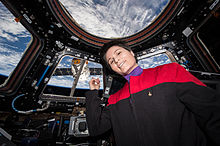
2022 European Space Agency Astronaut Group has invited particularly women and in a first case in human spaceflight people with disability (parastronauts) to apply for the group.[35]
China[]
In 2012, the Chinese space program sent their first woman to space.
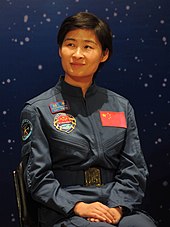
China's first female astronaut candidates, chosen in 2010 from the ranks of fighter pilots, were required to be married mothers.[36] The Chinese stated that married women were "more physically and psychologically mature" and that the rule that they had have had children was because of concerns that spaceflight would harm their reproductive organs (including unreleased ova).[36] The unknown nature of the effects of spaceflight on women was also noted.[36] However, the director of the China Astronaut Centre has stated that marriage is a preference but not a strict limitation.[37] Part of why they were so strict was because it was their first astronaut selection and they were trying be "extra cautious".[36] China's first woman astronaut, Liu Yang, was married but had no children at the time of her flight in June 2012.[38][39]
Wang Yaping became the second Chinese female astronaut as a member of the Shenzhou 10 spaceship crew, which orbited the Earth in June 2013, and of the Tiangong-1 orbiting space station with which it docked.
Other countries[]
- Yi So-yeon, South Korea (2008, state funded as space flight participant with Roscosmos)
- Jessica Meir, Sweden (2019, due to dual citizenship, though flown as US astronaut)
Women space tourists[]
After the second privately co-funded person overall and first woman Helen Sharman, Anousheh Ansari was the fourth overall privately funded space traveler, the first Iranian woman citizen (dual citizenship with the US) to go to space, as well as the first privately funded woman to fly to the International Space Station. She flew to the station in 2006 on the Soyuz TMA-9 spacecraft.[40] Her mission launched from the Baikonur Cosmodrome on September 18, 2006. Soyuz TMA-9 transported two-thirds of ISS Expedition 14 to the space station along with Ansari.[41] Ansari performed several experiments on behalf of the European Space Agency.[41]
Space flight participant[]
As the somewhat broader category of "space flight participants" four women have been classified: Helen Sharman, Claudie Haigneré (state funded), Anousheh Ansari, and Yi So-yeon (state funded).[14]
Commercial astronaut[]
In 2019 Beth Moses became the first commercial astronaut woman to go to space (sub-orbital). On 16 September 2021, Sian Proctor and Hayley Arceneaux became the first female commercial astronauts to go into orbit on board Inspiration4[42][43]
Fatalities[]


Payload Specialist Christa McAuliffe and mission specialist Judith Resnik became the first women to die on a space mission when the Space Shuttle Challenger exploded less than 2 minutes after launch with the loss of all hands.[44][45][46][47][48]


In the 2003 Space Shuttle Columbia disaster the crew was lost on re-entry, including mission specialists Kalpana Chawla and Laurel Clark.[49]
Discrimination[]
Space programs allowed women generally only well into the space age, with NASA opening its space program in 1976. When Sally Ride became in 1983 the first female US astronaut to go into space, the press asked her questions about her reproductive organs and whether she would cry if things went wrong on the job.[50]
Women with children have also been faced with questions about how they would compare to traditional expectations of motherhood.[51] Shannon Lucid, one of the first group of female US astronauts, remembers questions by the press on how her children would handle her being a mother in space.[52] Women are often expected to be the ones mainly responsible for child-rearing, which can impact their career.[53]
Physical effects of space on women[]
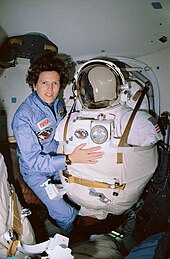
Female astronauts are subject to the same general physical effects of space travel as men. These include physiological changes due to weightlessness such as loss of bone and muscle mass, health threats from cosmic rays, dangers due to vacuum and temperature, and psychological stress.
NASA reports initially argued that menstruation could pose serious health risks or have a negative effect on performance, although it is now dealt with as a matter of routine.[54][55]
Astronaut clothing for men has been based on technology used to make bras, and since women have been sent to space, the previously men focused clothing has been reconsidered addressing the issues and needs for clothing like space suits for extravehicular activity (EVA) and bras, e.g. for exercise in micro-g environments.[56] Low number of produced smaller sized space suits has been hindering women astronauts to do EVAs because of a lack of fitting suits.[56]
Furthermore space toilet designs did not have women in mind, until October 2020 when the first toilet with better design for women (as well as men) was delivered to the ISS.
Radiation and uterine and breast cancer[]
Both men and women are affected by radiation. Massive particles are a concern for astronauts outside the earth's magnetic field who receive solar particles from solar proton events (SPE) and galactic cosmic rays from cosmic sources. These high-energy charged nuclei are blocked by Earth's magnetic field but pose a major health concern for astronauts traveling to the moon and to any distant location beyond the earth orbit. Evidence indicates past solar particle event (SPE) radiation levels that would have been lethal for unprotected astronauts.[57]
However, due to the currently used risk models for endometrial, ovarian and breast cancer, women at NASA can currently only spend half as much time on missions as men, which limits their career options compared to men.[58]
German standards for pregnant woman set a limit of 50 mSv/year for the gonads (ovaries) and uterus, and 150 mSv/year for the breasts.[59]
Astronauts on Apollo and Skylab missions received on average 1.2 mSv/day and 1.4 mSv/day respectively.[60] Exposures on the ISS average 0.4 mSv per day[60] (150 mSv per year), although frequent crew rotations minimize risk to individuals.[61] A trip to Mars with current technology might be related to measurements by the Mars Science Laboratory which for a 180-day journey estimated an exposure approximately 300 mSv, which would be equivalent of 24 CAT scans or "15 times an annual radiation limit for a worker in a nuclear power plant".[62]
Fertility[]
A study published in 2005 in the International Journal of Impotence Research reported that short-duration missions (no longer than nine days) did not affect "the ability of astronauts to conceive and bear healthy children to term."[36] In another experiment, the frog Xenopus laevis successfully ovulated in space.[63]
Pregnancy[]
NASA has not permitted pregnant astronauts to fly in space,[64] and there have been no pregnant women in space.[65] However, various science experiments have dealt with some aspects of pregnancy.[65]
For air travel, the United States' Federal Aviation Administration recommends a limit of 1 mSv total for a pregnancy, and no more than 0.5 mSv per month.[66]
For fetus radiation increases the risk of childhood cancers.[67] Additionally children of female astronauts could be sterile if the astronaut were exposed to too much ionizing radiation during the later stages of a pregnancy.[68] Ionizing radiation may destroy the egg cells of a female fetus inside a pregnant woman, rendering the offspring infertile even when grown.[68]
While no human had gestated in space as of 2003, scientists have conducted experiments on non-human mammalian gestation.[69] Space missions that have studied "reproducing and growing mammals" include Kosmos 1129 and 1154, as the Shuttle missions STS-66, 70, 72, and 90.[70] A Soviet experiment in 1983 showed that a rat that orbited while pregnant later gave birth to healthy babies; the babies were "thinner and weaker than their Earth-based counterparts and lagged behind a bit in their mental development," although the developing pups eventually caught up.[65]
The lack of knowledge about pregnancy and birth control in micro-gravity has been noted in regards to conducting long-term space missions.[64]
Post-natal[]
A 1998 Space Shuttle mission showed that rodent Rattus mothers were either not producing enough milk or not feeding their offspring in space.[71] However, a later study on pregnant rats showed that the animals successfully gave birth and lactated normally.[65]
To date no human children have been born in space; neither have children gone into space.[65] Nevertheless, the idea of children in space is taken seriously enough that some have discussed how to write curriculum for children in space-colonizing families.[72]
Statistics[]
As of January 2018
Non-astronaut personnel[]
Astronautics is the science behind going to space, and has been made possible beside the woman astronauts particularly by the many women who have been working in this and related fields.
To name some:
- Eilene Galloway
- Laurel van der Wal
- Katherine Johnson
- Mary Jackson
- Dorothy Vaughan
- Nichelle Nichols
A number of other high-profile women have contributed to interest in space programs. In the early 2000s, Lori Garver initiated a project to increase the visibility and viability of commercial spaceflight with the "AstroMom" project. She aimed to fill an unused Soyuz seat bound for the International Space Station because "…creating a spacefaring civilization was one of the most important things we could do in our lifetime.”[75]
See also[]
- List of female astronauts
- List of spaceflight records
- List of space travelers by nationality
- Maximum Absorbency Garment (NASA garment to help contain bodily emissions during spaceflight for men and women)
- Mercury 13
- List of female explorers and travelers
- Human presence in space
References[]
- ^ "Four Women will Fly in Space for the First Time in the History". Russian Federal Space Agency. 3 April 2010. Archived from the original on 8 April 2010. Retrieved 3 April 2010.
- ^ a b Alice Gorman (16 June 2020). "Almost 90% of astronauts have been men. But the future of space may be female". Retrieved 18 December 2020.
- ^ "Valentina Tereshkova". starchild.gsfc.nasa.gov. Retrieved 2021-11-09.
- ^ "Here's why women may be the best suited for spaceflight". National Geographic. 2019-06-13. Retrieved 2021-05-26.
- ^ Davenport, Christian (2019-12-09). "At Nasa, women are still facing outdated workplace sexism". The Independent. Retrieved 2021-06-10.
- ^ a b "Women in space: Roscosmos sets sights on creating female crew of cosmonauts, says source". TASS. 2019-01-21. Retrieved 2021-06-10.
- ^ a b c d e f g Malashenko, Uliana (2019-04-12). "The First Group of Female Cosmonauts Were Trained to Conquer the Final Frontier". Smithsonian Magazine. Retrieved 2021-05-26.
- ^ a b Burgess & Hall 2009, p. 229.
- ^ Hall, Rex D.; Shayler, David J.; Vis, Bert (2007). Russia's Cosmonauts: Inside the Yuri Gagarin Training Center. Springer. p. 103. ISBN 978-0-387-73975-5.
- ^ a b Burgess & Hall 2009, p. 236.
- ^ Eidelman, Tamara (2013). "A Cosmic Wedding". Russian Life. 56 (6): 22–25.
- ^ "50yrs ago, Tereshkova became first woman in space". Bangkok Post. Agence France-Presse. 16 June 2013. Retrieved 12 October 2019.Nikolaeva-Tereshkova, Valentina Vladimirovna (2015). "Preface". The 'First Lady of Space': In Her Own Words. Bethesda, MD: SpaceHistory101.com Press. pp. 4–7. ISBN 978-1-887022-99-6. OCLC 930799309. Reprint of Tereshkova, Valentina (2003). "The 'First Lady of Space' Remembers". Quest: The History of Spaceflight Quarterly. 10 (2): 6–21.CS1 maint: postscript (link)
- ^ Gibson, Karen (2014). Women in Space: 23 Stories of First Flights, Scientific Missions, and Gravity-Breaking Adventures. Chicago Review Press. p. 55. ISBN 978-1-61374-847-3.
- ^ a b c d e f Garber, Stephen (July 2017) [July 6, 2015]. "Women in Space". NASA History Program Office. National Aeronautics and Space Administration. Retrieved March 5, 2018.
- ^ Weitekamp, Margaret A.; Garber, Steve. "Lovelace's Woman in Space Program". NASA.
- ^ a b "Nichelle Nichols, NASA Recruiter". NASA. Archived from the original on 2009-12-22. Retrieved 2019-01-09.
From the late 1970s until the late 1980s, NASA employed Nichelle Nichols to recruit new astronaut candidates. Many of her new recruits were women or members of racial and ethnic minorities, including Guion Bluford (the first African-American astronaut), Sally Ride (the first female American astronaut), Judith Resnik (one of the original set of female astronauts, who perished during the launch of the Challenger on January 28, 1986), and Ronald McNair (the second African-American astronaut, and another victim of the Challenger accident).
- ^ Arcynta Ali Childs (2011-06-11). "Q & A: Nichelle Nichols, AKA Lt. Uhura, and NASA". Smithsonian.com. Retrieved 2019-01-09.
Ten years after "Star Trek" was cancelled, almost to the day, I was invited to join the board of directors of the newly formed National Space Society. They flew me to Washington and I gave a speech called “New Opportunities for the Humanization of Space” or “Space, What’s in it for me?” In [the speech], I’m going where no man or woman dares go. I took NASA on for not including women and I gave some history of the powerful women who had applied and, after five times applying, felt disenfranchised and backed off. [At that time] NASA was having their fifth or sixth recruitment and women and ethnic people [were] staying away in droves. I was asked to come to headquarters the next day and they wanted me to assist them in persuading women and people of ethnic backgrounds that NASA was serious [about recruiting them]. And I said you’ve got to be joking; I didn’t take them seriously. . . . John Yardley, who I knew from working on a previous project, was in the room and said 'Nichelle, we are serious.' I said OK. I will do this and I will bring you the most qualified people on the planet, as qualified as anyone you’ve ever had and I will bring them in droves. And if you do not pick a person of color, if you do not pick a woman, if it’s the same old, same old, all-white male astronaut corps, that you’ve done for the last five years, and I’m just another dupe, I will be your worst nightmare.
- ^ Wade, Mark. "Resnik". Archived from the original on 2009-10-08. Retrieved 2009-11-21.
- ^ Gibson, Karen (2014). Women in Space: 23 Stories of First Flights, Scientific Missions, and Gravity breaking Adventures. Chicago, Illinois: Chicago Review Press Incorporated. ISBN 978-1-61374-844-2.
- ^ Dunbar, Brian (2018-01-12). "With Every First in Space, New Dreams Are Launched". NASA. Retrieved 2021-06-02.
- ^ "Charting each generation of NASA astronauts reveals how the 'right stuff' has changed". National Geographic. 2021-06-02. Retrieved 2021-06-02.
- ^ a b c Jackson, Amanda; Boyette, Chris (June 17, 2019). "NASA plans to land the first woman on the moon by 2024". CNN. Retrieved 19 February 2021.
- ^ a b c Drake, Nadia (2020-12-09). "One of these astronauts may be the first woman on the moon". National Geographic. Retrieved 2021-02-19.
- ^ "First Russian woman in International Space Station mission". BBC News. 26 September 2014. Retrieved 6 October 2014.
- ^ "Russia's only female cosmonaut expected to make spaceflight in autumn of 2022". TASS. 27 June 2020. Retrieved 27 June 2020.
- ^ "Dr. Roberta Lynn Bondar: Canada's First Female Astronaut". Sault History Online. Sault Ste. Marie Public Library. 2008. Archived from the original on 2011-09-28. Retrieved 2011-04-17.
- ^ "Inventive Women Biographies: Julie Payette". Inventive Women. Inventive Women Inc. 2006. Archived from the original on February 17, 2009.
- ^ [[]]], Canadian Space Agency (2020-01-10). "Biography of Dr. Jennifer (Jenni) Anne MacKinnon Sidey-Gibbons". Canadian Space Agency.CS1 maint: numeric names: authors list (link)
- ^ "Astronaut Bio: Chiaki Mukai". NASA. October 2003.
- ^ Harwood, William. "Shuttle Lifts Off for Space Station", The New York Times, New York City, April 5, 2010. Retrieved on 2010-04-05.
- ^ "Astronaut set to become Japan's first mum in space". Reuters UK. Reuters. November 11, 2008. Retrieved November 18, 2008.
- ^ JAXA (November 11, 2008). "Naoko Yamazaki to become second Japanese female astronaut to fly to space". Japan Aerospace Exploration Agency. Archived from the original on December 13, 2009. Retrieved 2008-11-18.
- ^ NASA (2008). "Consolidated Launch Manifest". NASA. Retrieved October 25, 2008.
- ^ a b c d e "Naoko Yamazaki, JAXA Astronaut". National Aeronautics and Space Administration. April 2010. Archived from the original on July 26, 2015. Retrieved January 7, 2017.
- ^ "European Space Agency in bid to recruit female and disabled astronauts". euronews. 2021-02-16. Retrieved 2021-02-17.
- ^ a b c d e Brenhouse, Hillary (March 25, 2010). "China: Female Astronauts Must Be Married with Children". TIME.
- ^ "Exclusive interview: Astronauts selection process". CCTV News. CNTV. June 16, 2012. Archived from the original on December 13, 2014. Retrieved June 17, 2012.
- ^ 孙兰兰 贾磊 (2012-06-13). "女航天员刘洋婆婆:希望媳妇能尽快生个孩子_资讯频道_凤凰网" [Mother-in-law of female astronaut Liu Yang: I hope daughter-in-law gives birth to a child as soon as possible]. News.ifeng.com. Retrieved 2012-06-18.
- ^ Amos, Jonathan (June 16, 2012). "China launches space mission with first woman astronaut". BBC. Retrieved June 16, 2012.
- ^ Ansari, Anousheh; Hickam, Homer (March 2, 2010). My Dream of Stars: From Daughter of Iran to Space Pioneer. St. Martin's Press. ISBN 9780230105799. Archived from the original on March 9, 2014. Retrieved December 25, 2016.
- ^ a b "ESA experiments with spaceflight participant Ansari to ISS". International Space Center. European Space Agency. 12 September 2006. Retrieved 2006-09-22.
- ^ "Inspiration4 Crew Launches First All-Civilian Orbital Mission to Space". inspiration4.com. Retrieved 20 September 2021.
- ^ "SpaceX launches Inspiration4, first all-private orbital mission". nasaspaceflight.com. Retrieved 20 September 2021.
- ^ Lathers, Marie (2010). Space Oddities: Women and Outer Space in Popular Film and Culture, 1960-2000. The Continuum International Publishing Group. p. 106. ISBN 978-1-4411-9049-9.
- ^ Corrigan, Grace George (2000). A Journal for Christa: Christa McAuliffe, Teacher in Space. Lincoln, NE: University of Nebraska Press. p. 123. ISBN 9780803264113.
- ^ "The Crew of the Challenger Shuttle Mission in 1986". NASA. 2004-10-22.
- ^ Corrigan 2000, p. 40
- ^ Burgess, Colin; Corrigan, Grace George (2000). Teacher in space: Christa McAuliffe and the Challenger legacy. Lincoln, NE: University of Nebraska Press. ISBN 978-0-8032-6182-2.
- ^ "Reflections on the Loss of STS-107, the Space Shuttle Columbia: Ten Years Ago". February 2013.
- ^ Ryan, Michael. "A Ride in Space – NASA, Sally Ride". People. Retrieved December 5, 2013.
- ^ "Astronaut Mom Karen Nyberg Prepares for Mission and Motherhood 255 Miles Up". International Space Station. NASA. May 9, 2013.
- ^ Foster, Amy E. (December 2011). Integrating Women Into the Astronaut Corps: Politics and Logistics at NASA, 1972-2004. Baltimore, Maryland: The Johns Hopkins University Press. p. 146. ISBN 978-1-4214-0195-9.
- ^ Kramer, A. (July 2, 2013). "Parenting From Earth's Orbit". The New York Times.
- ^ Teitel, Amy Shira (June 10, 2016). "A Brief History Of Menstruating In Space: Before women started flying in space, NASA was a little worried they might die having their periods". Popular Science. Bonnier Corporation. Retrieved January 7, 2017.
- ^ Beck, Julie (April 21, 2016). "Women Astronauts: To Menstruate or Not to Menstruate". The Atlantic. Retrieved January 7, 2016.
- ^ a b Sokolowski, Susan L. (5 April 2019). "Female astronauts: How performance products like space suits and bras are designed to pave the way for women's accomplishments". The Conversation. Retrieved 10 May 2020.
- ^ Battersby, Stephen (21 March 2005). "Superflares could kill unprotected astronauts". New Scientist. Reed Business Information Ltd.
- ^ Kramer, Miriam (August 27, 2013). "Female Astronauts Face Discrimination from Space Radiation Concerns, Astronauts Say". Space.com. Purch. Retrieved January 7, 2017.
- ^ Koelzer, Winfried (January 2011). "Radiation exposure, dose limits, Germany". Glossary of nuclear terms. European Nuclear Society. Archived from the original on November 13, 2016. Retrieved January 7, 2017.
- ^ a b Cucinotta, Francis A., "Table-4. Average dose (D) or dose-rate recorded by dosimetry badge and estimates of the effective doses, E received by crews in NASA programs through 2004" (PDF), Space Radiation Organ Doses for Astronauts on Past and Future Missions, p. 22, retrieved 1 February 2014
- ^ W., Anderson, Rupert. The cosmic compendium : space medicine. [printer not identified]. [Place of publication not identified]. ISBN 9781329052000. OCLC 935213314.
- ^ Gifford, Sheyna E. (February 18, 2014). "Calculated Risks: How Radiation Rules Manned Mars Exploration". Astrobiology Magazine. National Aeronautics and Space Administration. Retrieved January 7, 2017.
- ^ Ronca, p. 218.
- ^ a b Foster, p. 139.
- ^ a b c d e Stierwalt, Sabrina (May 2006). "Can a human give birth in space?". Ask an Astronomer. Cornell University.
- ^ Davis, Jeffrey R.; Johnson, Robert; Stepanek, Jan; Fogarty, Jennifer A., eds. (2008). Fundamentals of Aerospace Medicine (Fourth ed.). pp. 221–230. ISBN 9780781774666. Retrieved January 7, 2017.
- ^ Radiology Clinician Fact Sheet: Radiation Information (PDF), NSW Agency for Clinical Innovation, September 2012, retrieved January 7, 2017
- ^ a b Taylor, Jerome (February 14, 2011). "Why infertility will stop humans colonising space". The Independent.
- ^ Ronca, April E. (July 15, 2003), "Mammalian Development in Space", in Cogoli, Augusto (ed.), Advances in Space Biology and Medicine, 9, Elsevier Science B.V., p. 219, ISBN 978-0-444-51353-3
- ^ Ronca, p. 222.
- ^ "Nasa To Probe The Deaths Of 51 Baby Rats In Space". Chicago Tribune. April 29, 1998.
- ^ Britton, Alan (2010-11-04), "A school curriculum for the children of stace settlers", in Landfester, Ulrike; Remuss, Nina-Louisa; Schrogl, Kai-Uwe; Worms, Jean-Claude (eds.), Humans in Outer Space: Interdisciplinary Perspectives, p. 65, ISBN 9783709102800
- ^ "Astronaut Christina Koch sets new record for longest single space flight by a woman". CBS News. 27 December 2019. Retrieved 28 December 2019.
- ^ Harwood, William. "3 station fliers complete "once-in-a-lifetime ride" home after 204-day stay in orbit". cbsnews.com. Retrieved 2020-02-20.
- ^ Foust, Jeff (November 19, 2007). "AstroMom and Basstronaut, revisited". The Space Review.
- Burgess, Colin; Hall, Rex (2009). The First Soviet Cosmonaut Team. Chichester, UK: Praxis Publishing. ISBN 978-0-387-84824-2. LCCN 2008935694.
External links[]
- Women in Space from Telegraph Jobs
- 50 years of humans in space: European Women in Space (ESA)
- Women in space
- Human spaceflight
